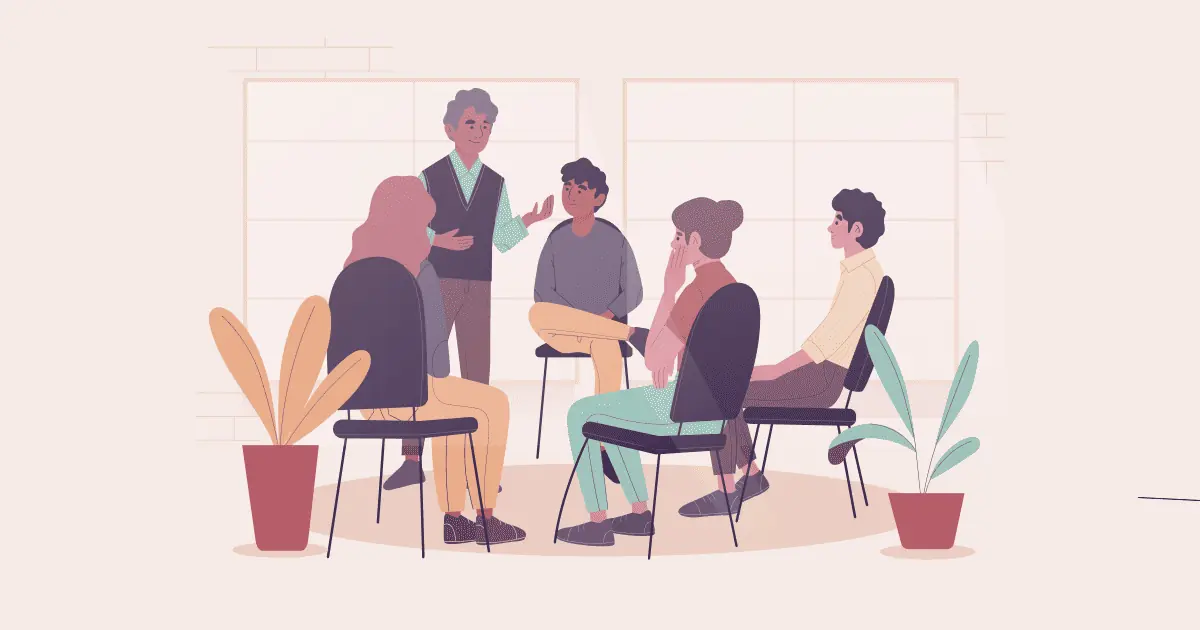Wat uw lichaamstaal tijdens presentatie Wat zegt over jou? Wat wel en niet te doen! Laten we de beste tips van AhaSlides leren!
Dus, wat is de beste presentatiehouding? Last van het awkward hands-syndroom? Waarschijnlijk niet, want dat heb ik net verzonnen. Maar we hebben allemaal wel eens momenten dat we niet weten wat we met onze handen, benen of welk lichaamsdeel dan ook moeten doen.
Misschien heb je een fantastische ijsbreker, onberispelijk introductie, en een uitstekende presentatie, maar de uitvoering is waar het om draait. Je weet niet wat je met jezelf aan moet, en het is perfect een.
Overzicht
| Wat is de lichaamstaal van schaamte? | neerwaartse blik, glimlachcontroles, weggedraaide hoofdbewegingen en het aanraken van het gezicht |
| Wat zijn de non-verbale signalen van schaamte?? | Ingezakte schouders, het hoofd laten zakken, naar beneden kijken, geen oogcontact, onsamenhangende spraak |
| Merkt het publiek dat een presentator verlegen is? | Ja |
| Waarom was de presentatie van Steve Jobs zo goed? | Hij heeft gewoon veel geoefend, en daarbij ook nog eens interessant presentatie outfits |

Tips voor een betere betrokkenheid
- Persoonlijkheid in een presentatie
- Hoe uit jij jezelf?
- Gebruik live woordwolken or live Q&A naar onderzoek uw publiek makkelijker!
- Gebruik brainstormtool effectief door AhaSlides ideeënbord

Begin binnen enkele seconden.
Ontvang gratis sjablonen voor uw volgende interactieve presentatie. Meld u gratis aan en neem wat u wilt uit de sjabloonbibliotheek!
🚀 Ontvang gratis sjablonen
In hoeverre weet je hoe je een succesvolle presentatie moet geven? Naast goed ontworpen PowerPoint-sjablonen is het belangrijk om ook andere presentatievaardigheden te gebruiken, met name lichaamstaal.
Nu u weet dat lichaamstaal een onvervangbaar onderdeel is van presentatievaardigheden, is het nog een lange weg om deze vaardigheden onder de knie te krijgen en zo een effectieve presentatie te geven.
Dit artikel geeft u een holistisch beeld van lichaamstaal en hoe u deze vaardigheden kunt gebruiken voor perfecte presentaties.
Inhoudsopgave
- Overzicht
- Tips voor een betere betrokkenheid
- Het belang van lichaamstaal tijdens een presentatie
- 10 tips om lichaamstaal in presentaties onder de knie te krijgen
- 4 tips voor lichaamsbewegingen
- Veelgestelde Vragen / FAQ
Het belang van lichaamstaal voor presentatie
Bij lichaamstaalpresentaties hebben we het, als het om communicatie gaat, over verbale en non-verbale termen. Het is cruciaal om te onthouden dat deze termen een relatieve relatie hebben. Dus, wat is het?
Verbale communicatie is het gebruik van woorden om informatie met anderen te delen, zowel gesproken als geschreven taal. Bijvoorbeeld het woord "hoe gaat het" dat je kiest om anderen te laten begrijpen wat je probeert te zeggen.
Non-verbale communicatie is de overdracht van informatie via lichaamstaal, gezichtsuitdrukkingen, gebaren, gecreëerde ruimte en meer. Zo straalt een glimlach bij een ontmoeting vriendelijkheid, acceptatie en openheid uit.
Of je je er nu van bewust bent of niet, in de omgang met anderen geef en ontvang je naast praten constant woordloze signalen. Al je non-verbale gedrag – je houding, je intonatie, de gebaren die je maakt en hoeveel oogcontact je maakt – brengt essentiële boodschappen over.
Ze kunnen mensen met name op hun gemak stellen, vertrouwen wekken en de aandacht trekken, maar ze kunnen ook beledigend en verwarrend zijn voor wat je probeert uit te drukken. Deze boodschappen stoppen ook niet wanneer je stopt met praten. Zelfs als je zwijgt, communiceer je nog steeds non-verbaal.
Een presentatie is ook een manier om met je publiek te communiceren; terwijl je je idee uitdraagt, gebruik je lichaamstaal om het te benadrukken. Door het belang van non-verbale en verbale communicatievaardigheden tegelijkertijd te begrijpen, voorkom je saaie presentaties.
Om het wat eenvoudiger te maken, onderzoeken we elementen van lichaamstaal, een onderdeel van non-verbale communicatievaardigheden. Lichaamstaal omvat gebaren, houdingen en gezichtsuitdrukkingen. Tijdens een presentatie wordt een krachtige en positieve lichaamstaal een krachtig instrument om geloofwaardigheid op te bouwen, je emoties te uiten en contact te maken met je luisteraars. Het helpt je luisteraars ook om zich meer op jou en je toespraak te concentreren. Hier geven we je meer dan 10 voorbeelden van lichaamstaal en tips om je
10 tips om lichaamstaal in presentaties onder de knie te krijgen
Denk aan je uiterlijk
Ten eerste is het essentieel om er netjes uit te zien tijdens presentaties. Afhankelijk van de gelegenheid moet u misschien de juiste outfit en goed verzorgd haar voorbereiden om uw professionaliteit en respect voor uw luisteraars te tonen.
Denk na over het type en de stijl van het evenement; ze kunnen een strikte dresscode hebben. Kies een outfit waarbij je je eerder evenwichtig en zelfverzekerd voelt voor een publiek. Vermijd kleuren, accessoires of sieraden die het publiek kunnen afleiden, lawaai kunnen maken of verblinding kunnen veroorzaken onder podiumverlichting.
Glimlach en lach nog eens
Vergeet niet te "glimlachen met je ogen" in plaats van alleen met je mond als je lacht. Het zou helpen om anderen je warmte en oprechtheid te laten voelen. Vergeet niet om de glimlach te behouden, zelfs na een ontmoeting - in nep-geluksontmoetingen; je ziet misschien vaak een "aan-uit"-glimlach die flitst en snel verdwijnt nadat twee mensen hun eigen weg gaan.
Open je handpalmen
Zorg ervoor dat je handen meestal open zijn als je met je handen gebaart, zodat mensen je open handpalmen kunnen zien. Het is ook een goed idee om je handpalmen meestal naar boven te richten in plaats van naar beneden.
Oogcontact maken
Het is meestal een slecht idee om oogcontact te maken met individuele leden van uw publiek! Het is noodzakelijk om een goede plek te vinden voor ‘lang genoeg’ om naar je luisteraars te kijken zonder aanstootgevend of griezelig te zijn. Probeer het eens om ongeveer 2 seconden naar anderen te kijken om onhandigheid en nervositeit te verminderen. Kijk niet naar je aantekeningen om meer verbinding te maken met je luisteraars.
Bekijk tips over Oogcontact in communicatie
Handgeklemd
U kunt deze gebaren nuttig vinden wanneer u een vergadering wilt beëindigen of een interactie met iemand wilt beëindigen. Als je zelfverzekerd wilt overkomen, kun je deze keu gebruiken met je duimen uitgestoken - dit duidt op vertrouwen in plaats van stress.
Bladen
In het bijzijn van goede vrienden en vertrouwde mensen is het heerlijk om af en toe je handen in je zakken te laten rusten. Maar als je de ander onzeker wilt maken, is je handen diep in je zakken steken een gegarandeerde manier om dat te doen!
oor aanraken
Het oor aanraken of een zelfverzachtend gebaar vindt onbewust plaats wanneer een persoon angstig is. Maar weet je dat het een goede hulp is bij moeilijke vragen van het publiek? Als u uw oor aanraakt bij het bedenken van oplossingen, kan uw algehele houding natuurlijker worden.
Wijs niet met je vinger
Wat je ook doet, wijs niet. Zorg er alleen voor dat je het nooit doet. Met de vinger wijzen tijdens het praten is in veel culturen taboe, niet alleen tijdens presentaties. Mensen vinden het altijd agressief en ongemakkelijk, op de een of andere manier beledigend.
Bedien je stem
Spreek in elke presentatie langzaam en duidelijk. Als je de belangrijkste punten wilt benadrukken, kun je nog langzamer spreken en ze herhalen. Intonatie is belangrijk; laat je stem op en neer gaan om natuurlijk te klinken. Zeg soms een tijdje niets om de communicatie te verbeteren.
Rondlopen
Bewegen of op één plek blijven tijdens een presentatie is prima. Maar overdrijf het niet; vermijd de hele tijd heen en weer lopen. Loop wanneer je het publiek wilt boeien, wanneer je een grappig verhaal vertelt of wanneer het publiek lacht.
4 tips voor lichaamsbewegingen
In dit artikel geven we je een aantal snelle tips over lichaamstaal en hoe je je presentatievaardigheden kunt verbeteren met betrekking tot:
- Oogcontact
- Handen en schouders
- Benen
- Achterhoofd
Je lichaamstaal is cruciaal omdat het je niet alleen aantrekkelijk maakt, maar ook een positieve indruk achterlaat. blik zelfverzekerder, assertiever en beheerster, maar je zult ook eindigen gevoel Deze dingen. Je moet ook vermijden om naar beneden te kijken tijdens het praten.
Ogen – Lichaamstaal tijdens presentatie
Don't Vermijd oogcontact alsof het de pest is. Veel mensen weten niet hoe ze oogcontact moeten maken en worden geleerd om naar de achterwand of iemands voorhoofd te staren. Mensen merken het wanneer je niet naar hen kijkt en zullen je als nerveus en afstandelijk ervaren. Ik was zo'n presentator, omdat ik dacht dat spreken in het openbaar hetzelfde was als acteren. Toen ik op de middelbare school theatervoorstellingen deed, moedigden ze ons aan om naar de achterwand te kijken en geen contact te maken met het publiek, omdat het hen zou afleiden van de fantasiewereld die we creëerden. Ik heb op de harde manier geleerd dat acteren niet hetzelfde is als spreken in het openbaar. Er zijn vergelijkbare aspecten, maar je wilt het publiek niet van je presentatie afschermen – je wilt ze erbij betrekken, dus waarom zou je doen alsof ze er niet zijn?
Aan de andere kant wordt sommige mensen geleerd om naar slechts één persoon te kijken, wat ook een slechte gewoonte is. De hele tijd naar één persoon staren zal hen erg ongemakkelijk maken en die sfeer zal ook de andere toeschouwers afleiden.

DO Maak contact met mensen zoals je dat in een normaal gesprek zou doen. Hoe verwacht je dat mensen met je in gesprek willen gaan als ze zich niet gezien voelen? Een van de meest nuttige presentatievaardigheden die ik heb geleerd van Nicole Dieker is dat mensen van aandacht houden! Neem de tijd om contact te maken met je publiek. Als mensen het gevoel hebben dat een presentator om hen geeft, voelen ze zich belangrijk en aangemoedigd om hun emoties te delen. Verleg uw aandacht naar verschillende toehoorders om een inclusieve omgeving te bevorderen. Ga vooral om met degenen die al naar je kijken. Niets is erger dan naar iemand te staren die naar zijn telefoon of programma kijkt.
Gebruik zoveel oogcontact als u zou doen wanneer u met een vriend praat. Spreken in het openbaar is hetzelfde, alleen op grotere schaal en met meer mensen.
handen– Lichaamstaal tijdens presentatie
Beperk jezelf niet en denk er niet te lang over na. Er zijn zoveel manieren om je handen verkeerd vast te houden, zoals achter je rug (wat agressief en formeel overkomt), onder je riem (bewegingsbeperking), of stijf naast je lichaam (wat ongemakkelijk aanvoelt). Kruis uw armen niet; dit komt defensief en afstandelijk over. Het belangrijkste is: overdrijf niet! Dit wordt niet alleen vermoeiend, maar het publiek zal zich eerder gaan fixeren op hoe moe je moet zijn dan op de inhoud van je presentatie. Zorg ervoor dat uw presentatie gemakkelijk te bekijken en dus gemakkelijk te begrijpen is.

DO Leg je handen in een neutrale positie. Dit zal iets boven je navel zijn. De meest succesvolle neutrale positie is door één hand in de andere te houden of ze gewoon tegen elkaar te houden op de manier waarop je handen dat van nature zouden doen. Handen, armen en schouders zijn de belangrijkste visuele cue voor het publiek. moet gebaar zoals je typische lichaamstaal in een gewoon gesprek. Wees geen robot!
Hieronder een korte video van Steve Bavisteren ik raad u aan om de video te bekijken, zodat u kunt visualiseren wat ik zojuist heb beschreven.
Benen– Lichaamstaal tijdens presentatie
Don't sluit je benen en sta stil. Het is niet alleen gevaarlijk, maar je ziet er ook ongemakkelijk uit (waardoor het publiek zich ongemakkelijk voelt). En niemand voelt zich graag ongemakkelijk! Het bloed begint zich in uw benen te verzamelen en zonder beweging zal het bloed moeite hebben om naar het hart te recirculeren. Dit maakt je vatbaar voor flauwvallen, wat zeker zou zijn … je raadt het al … ongemakkelijk. Beweeg je benen daarentegen niet te veel. Ik ben bij een paar presentaties geweest waar de spreker heen en weer schommelde, heen en weer, en ik besteedde zoveel aandacht aan dit afleidende gedrag dat ik vergat waar hij het over had!

DO Gebruik je benen als verlengstuk van je handgebaren. Zet een stap naar voren als je een statement wilt maken dat je publiek aanspreekt. Zet een stap achteruit als je ruimte wilt creëren voor reflectie na een verbluffend idee. Er is een balans in alles. Beschouw het podium als één vlak – je moet je niet met je rug naar het publiek toekeren. Loop op een manier die iedereen in de ruimte omvat en beweeg je zo dat je vanaf elke plek zichtbaar bent.
Achterpaneel– Lichaamstaal tijdens presentatie
Don't Trek jezelf in met hangende schouders, een hangend hoofd en een gebogen nek. Mensen hebben onbewuste vooroordelen tegen deze vorm van lichaamstaal en zullen je capaciteiten als presentator in twijfel trekken als je je voordoet als een defensieve, zelfbewuste en onzekere spreker. Zelfs als je je niet identificeert met deze kenmerken, zal je lichaam dat wel laten zien.

DO overtuig hen van uw vertrouwen met uw houding. Ga rechtop staan alsof je hoofd is verbonden met een aangeleerde string die aan het plafond is bevestigd. Als je lichaamstaal vertrouwen weergeeft, zul je zelfverzekerd worden. U zult verrast zijn hoe weinig aanpassingen uw spraakbezorging verbeteren of verergeren. Probeer deze presentatievaardigheden in de spiegel te gebruiken en ontdek het zelf!
Ten slotte, als je vertrouwen hebt in je presentatie, zal je lichaamstaal drastisch verbeteren. Je lichaam zal weerspiegelen hoe trots je bent op je visuals en paraatheid. AhaSlides is een geweldig hulpmiddel om te gebruiken als u als presentator meer zelfvertrouwen wilt krijgen en uw publiek wilt verbazen met interactieve realtimehulpmiddelen die ze tijdens uw presentatie kunnen gebruiken. En het beste? Het is gratis!
Conclusie
Dus, wat zegt lichaamstaal tijdens de presentatie over jou? Laten we onze tips gebruiken en bekijken hoe je ze in je presentatie kunt verwerken. Aarzel niet om thuis of met een bekend publiek voor de spiegel te oefenen en om feedback te vragen. maakt perfect. Je zult je lichaamstaal beheersen en positieve resultaten uit je presentatie halen..
Extra fooi:Bij een virtuele online presentatie of het dragen van een mondkapje kunt u moeilijkheden ondervinden bij het tonen van lichaamstaal; u kunt overwegen uw presentatiesjabloon te gebruiken om de aandacht van het publiek te trekken met 100+ AhaSlides-typen presentatiesjablonen.
Veelgestelde Vragen / FAQ
Wat je met je handen moet doen bij het presenteren
Tijdens een presentatie is het belangrijk om je handen doelbewust te gebruiken om een positieve indruk te maken en je boodschap te versterken. Houd je handen daarom ontspannen met open handpalmen, gebruik gebaren om je presentatie te verbeteren en houd oogcontact met je publiek.
Waarom zou ik beide kanten van de kwestie moeten belichten als ik een presentatie geef aan een neutraal publiek?
Het is essentieel om beide kanten van een kwestie aan een neutraal publiek te presenteren. Dit draagt bij aan de betrokkenheid van het publiek, versterkt uw kritisch denkvermogen, verbetert uw presentatie en vergroot de geloofwaardigheid.
Welk soort gebaren moet je vermijden in een toespraak?
U moet afleidende gebaren vermijden, zoals: dramatisch spreken, maar niet relevant voor uw inhoud; friemelen, zoals tikken met je vingers of spelen met voorwerpen; wijzende vingers (die blijk geven van gebrek aan respect); armen over elkaar en verrassend en overdreven formele gebaren!






